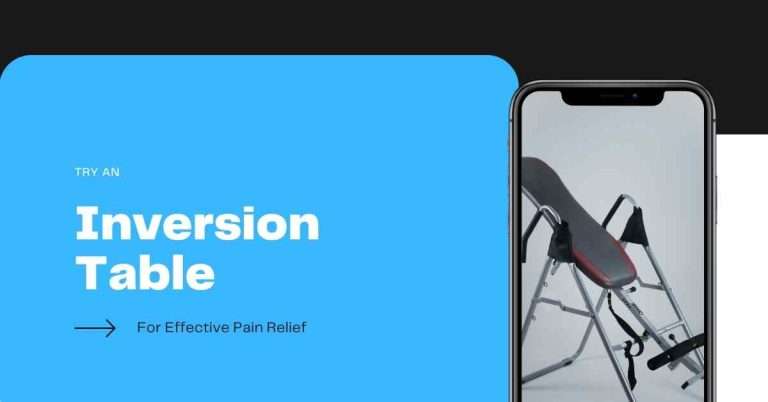Introduction
In non-invasive pain management, inversion tables have carved out a niche as both a popular and effective tool. These devices, which enable users to suspend themselves upside down or at an incline, have demonstrated their ability to offer substantial relief from back pain and other discomforts. This article delves deeper into the science of utilizing an inversion table for pain relief as a natural option.
The Mechanics of Inversion Tables

Inversion tables harness the power of gravity to alleviate back pain. Users secure themselves onto the table before tilting it, causing their bodies to invert or hang upside down. This inversion process helps to decompress the spine, potentially relieving back pain and promoting overall spinal health.
The Science Underpinning Inversion Tables
The efficacy of inversion tables in pain relief has been studied extensively. A study published in the International Journal of Medical Research and Health Sciences discovered that inversion therapy could significantly diminish the necessity for surgery in patients suffering from lumbar discogenic disease[^1^].
Similarly, another study featured in Pain Practice found that inversion therapy could aid patients with the lumbar disease by reducing the need for surgery and enhancing their quality of life[^2^].
The Pain Relief Mechanism of Inversion Tables

Inversion tables operate by counteracting the effects of gravity on the spine. When standing or sitting, gravity pulls our spine downward, compressing the discs between our vertebrae and potentially leading to pain. This gravitational pull is reversed by inverting the body, allowing the discs to decompress. Inversion can alleviate nerve pressure and improve circulation, contributing to pain relief.
Types of pain relief:
Inversion tables are primarily employed to assist with back pain. Still, they can potentially offer relief for a variety of discomforts. Here are some types of pain that an inversion table may help alleviate:
- Back Pain: This is the most prevalent use for inversion tables. Suspending oneself upside down can decompress the spine, which may alleviate back pain. It’s particularly beneficial for those with herniated discs, sciatica, or degenerative disc disease.
- Muscle Tension and Spasms: The decompression and gentle stretching during inversion therapy can help relax tense muscles and reduce muscle spasms, especially in the back and neck.
- Joint Pain: Inversion therapy can help alleviate joint pressure, benefiting people with arthritis or other joint disorders. Inversion tables are also effective for athletes after high-impact activities that can stress the joints.
- Sciatica and Pinched Nerves: By creating more space between the vertebrae, inversion tables can help relieve the pressure on pinched nerves, reducing pain and other symptoms associated with conditions like sciatica.
- Scoliosis: Some people with scoliosis find inversion therapy helpful for managing pain and discomfort associated with their condition.
- Improved Circulation: While not a type of pain, poor circulation may lead to discomfort and other health issues. Inversion therapy can help improve blood flow, which can promote overall well-being.
Considerations and Precautions
While inversion tables can be beneficial, they are not suitable for everyone. People with high blood pressure, heart disease, or glaucoma should avoid using inversion tables, as the upside-down position can increase pressure on the eyes and cardiovascular system.
Here are some of the highest-rated inversion tables on Amazon:
- Exerpeutic Inversion Table UL Certified: This inversion table stands out for its effectiveness in relieving neck pain. It’s UL certified, ensuring its safety and quality. Additionally, it features heat and massage therapy, enhancing its pain-relieving capabilities.
- Innova ITX9600: This is a budget-friendly option that doesn’t compromise on features. The table has affordability and functionality. The Innova ITX9600 is a heavy-duty inversion therapy table, ensuring durability and long-term use.
- Body Vision IT9550 Deluxe: This inversion table is recognized for its foldability, making it an excellent option for those with limited space. Additionally, it features an adjustable headrest and lumbar support pad for enhanced comfort during use.
- Harison Inversion Table HR-407: This inversion table is for larger individuals. It’s sturdy and designed to accommodate a higher weight capacity. The Harison Inversion Table also has 3D memory foam for added comfort and effective pain therapy.
Conclusion
Inversion tables present a non-invasive, drug-free approach to managing pain, particularly in the back. By harnessing the power of gravity, they can help decompress the spine, alleviate pressure on nerves, and promote better circulation.
Please note: This article is for informational purposes only and is not a replacement for professional medical advice. As always, consulting with a healthcare professional before starting inversion therapy or any new treatment regimen is crucial.
More Stories
Find more amazing stories on the blog!




